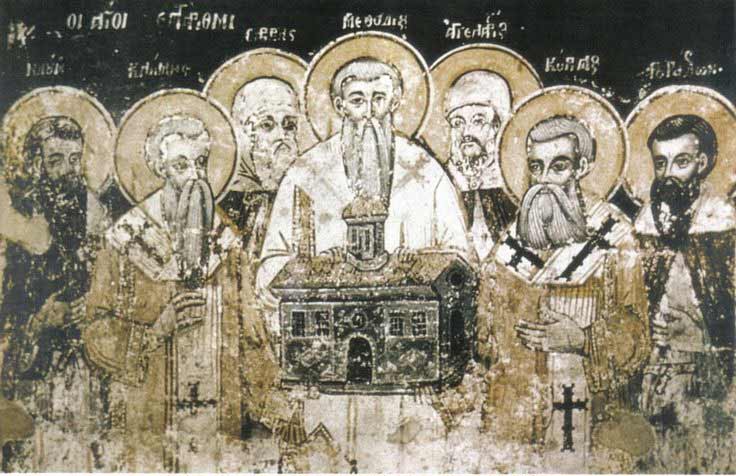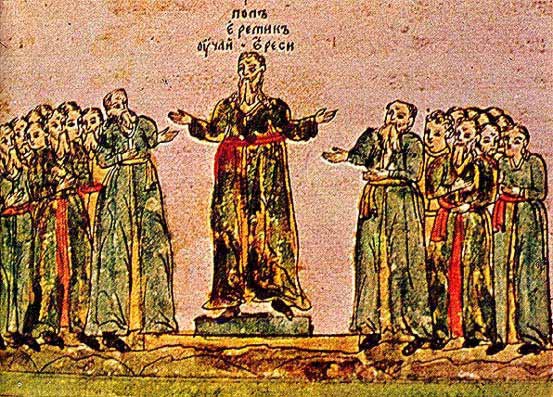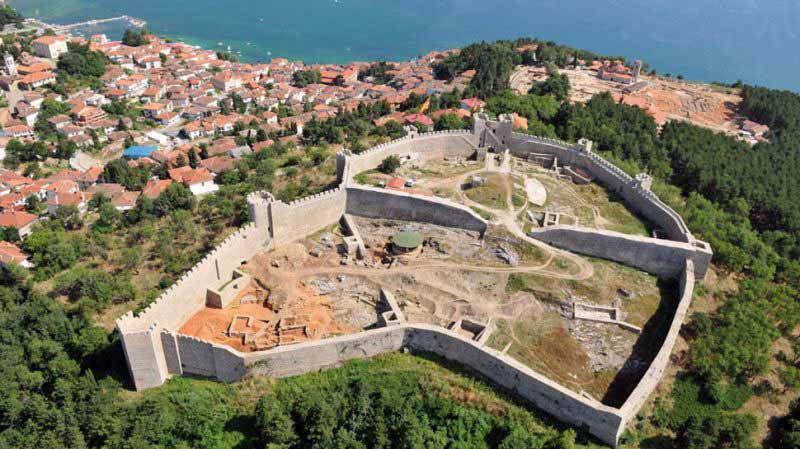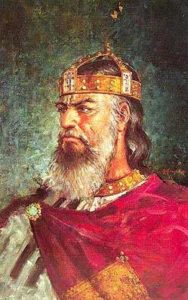As a result of the great migration of peoples a large number of Slavs moved from their ancient fatherland (the territory between the Baltic Sea, the Carpathians and the rivers Dnieper and Dniester) and by the close of the 5th century they had Slavicised the regions on the left bank of the River Danube. Thus the River Danube became a natural frontier between Byzantium and the Slavic world.
From the beginning of the 6th century the Byzantine dominions were subject to frequent massive movements and attacks on the part of the trans-Danubian Slavs. From then onward the territory of Macedonia (which was governed as a province of the Illyric prefecture whose capital was Salonica) was exposed to continual spoliation by the Slavs. These attacks became particularly frequent from the mid-6th century, when the Slavs began to take over Byzantine territory. From the 60’s of the 6th century the territory of Macedonia was also raped and pillaged by the Avars who had settled in the Pannonian plain.
From the close of the 6th century the territory of Macedonia, like the other Byzantine dominions in the Balkans, was exposed to continual settlement by the trans-Danubian Slav tribes. From that time onward the city of Salonica became an object of Slavonic and combined Slavonic and Avar sieges and attacks. As a result of large-scale and intensive Slav colonization, in the 30’s of the 7th century the whole territory of Macedonia, with the exception of Salonica, was settled by Slavs (1). Influenced by its Slavonic surroundings even Salonica underwent considerable Slavonic influence so that in the 9th century, in the Life of St. Methodius. it is written that “all the citizens of Salonica speak a pure Slavonic” (2). Thus, as was stated by the French Byzantine scholar P. Lemerle, “Macedonia in the 7th and 8th centuries was more Slavonic than Greek” (3). According to G. Ostrogorsky. Macedonia was at this time lost to Byzantium “and found itself in the hands of the Slavs, consisting of a conglomeration of Sklavinii” (4). These were the districts of distinct Slav tribes: the Dragoviti, Sagudati. Velegiziti. Strumjani. Smoljani, Rinhini, Berziti. etc. (5).
As a result of the Slav colonization of Macedonia certain radical ethnic and socio-economic changes took place. The Slavonic ethnos became dominant. The native inhabitants, the Macedonians, had continued to exist and, after the extinction of the ancient Macedonian state in the 2nd century BC at the hands of the Romans, as writes F. Papazoglou (6) “maintaining their ethnic characteristics, their language, their belief and customs’ they were by the period of Slavonic colonization already perceptibly diluted” (7). Those, however, who had remained in their native homesteads gradually became assimilated by particular Slavonic tribes, in the process transmitting to the Slavs certain of their own customs, the Christian faith, culture and also the name of their fatherland and their identity, Macedonia and Macedonians. This had the effect that the Byzantine authors of the 8th century called the Slavicised districts “the Sklavinii” in Macedonia (8).
In the course of the 7th century the Slav tribes which had settled in Macedonia were already attempting, through an association of larger tribal leagues, to take Salonica, which had remained as the single Byzantine base on the territory of Macedonia, and to create their own Slav state in Macedonia. The first such league was created in the second decade of the 7th century with Price Hacon at its head. Byzantium, however, succeeded in rendering it impossible for the associated Macedonian Slav tribes to capture Salonica. In the second half of the 7th century the Slavs in Macedonia once more came together in a larger tribal league led by Rex (“King”) Prebond. But this tribal league was also dispersed by Byzantium when Prebond was captured by deceit and put to death in 674. After his death the Macedonian Sklavinii were exposed to continual attacks from the Byzantine army; and yet, in spite of this, they were not subdued. In the course of the 8th century the Macedonian Sklavinii developed into anti-state formations, administered by their princes (archonts) and “kings” (reges). During this period the Sklavinii had at their disposal their own hoplites (heavily-armed infantrymen) (9).
With the strengthening of the Bulgarian state at the beginning of the 9th century, the Macedonian Sklavinii were also exposed to more frequent Bulgarian attacks, on account of which Byzantium continued and intensified its attacks along the River Struma. As a result of this by the mid-9th century the majority of the territory of Macedonia had fallen under Bulgarian rule. The Macedonians lost their independence but still retained a significant degree of internal self-government. Towards the close of the century the Bulgarian ruler Simeon included the whole of Macedonia within his frontiers.
However, a significant event in the history of Macedonia and the history of the Slavs in general took place in 863 when the distinguished Byzantine missionaries from Salonica, the brothers Sts. Cyril and Methodius and their disciples, set out for Moravia bearing with them the first books in a Slavonic language, written in the Glagolitic alphabet which they themselves had invented. It is of particular significance that this new form of writing was created on the basis of the phonetic principles of the Slavs in Macedonia (from the surroundings of Salonica) and that the first translations of the holy books were made into the language of the Macedonian Slavs. This was the fourth language, in addition to Hebrew, Greek and Latin, which was officially recognized by the Christian church.
The process of Christianisation was completed in Macedonia as early as the course of the second half of the 9th century. After the propagation of Sts. Cyril and Methodius’ Moravian mission (885), St. Clement, after a brief sojourn in Pliska, was nominated a teacher in the region of Kutmichevica, which included the south-western Macedonian districts (Strumica Region), and the Ohrid Glagolitic literary school was established. Thanks to St. Clement and, after 893, St. Naum (who took over the role of teacher when St. Clement was named the first Slav archbishop), about 3,500 Slav teachers, clergy, writers and other literary figures emerged from the Ohrid literary school whose activity was crowned with the laying of sound foundations for the building-up of the Slavonic cultural, educational and ecclesiastical organization (10).
In the first half of the 10th century Bogomil teaching, led by the priest Bogomil, appeared in Macedonia and became active chiefly in the Veles and Prilep regions. Within a short period of time Bogomilism had grown into a large-scale popular movement. Neither the Bulgarian Czar Peter nor help from the Patriarchate of Constantinople was able to eradicate this newly-appeared heresy (11). In such circumstances the Slavs in Macedonia raised a rebellion towards the close of the 60’s of the 10th century. At the head of the uprising were the sons of Prince Nikola, the comitopules David, Moses, Aaron and Samoil. The rebellion. which was against Bulgarian rule, was carried out successfully and as a result of this the foundations of a new Slav state in the Balkans, known as Samuil’s Empire after the founder of the imperial dynasty were laid in 969. Its nucleus was the territory of the former “Bersite” Sklavinia where the capital. Prespa was situated. This town became not merely a state but also in ecclesiastical seat. Up to 976 the four brothers were jointly ruling the state whose basic nucleus was made up of Macedonian Sklavinii. After the destruction of the Bulgarian Empire in 971 Byzantium imposed its supreme authority on this state, which continued to exist but as a vassal state. An uprising against Byzantine rule took place in Macedonia and as a result of this it once again attained its independence. In the same year Samuil’s brothers were killed and he became the sole monarch of the state. Within a short period of time Samuil had built up a body of military commanders and trained a large army. As a result of this, by the close of the 10th century, the entire territory of Macedonia (with the exception of Salonica), large parts of Bulgaria, Serbia, Duclia and Bosnia, a part of Dalmatia, part of Albania including Dyrrachium and a part of Greece had been included within the borders of this state. After their considerable territorial conquests Samuil was proclaimed Emperor in his capital of Prespa which was situated on the island of Achilleus in the lake of Prespa and was crowned by the Pope of Rome and thus his state was transformed into an empire and the church was elevated to the rank of an archbishopric (12).
State institutions were established in Samuil’s state and vast state and ecclesiastical systems were formed as well as a standing army. All of this enabled Macedonia to institute the process of tribal integration into a people in the 10th century. And thus the tradition of Samuil, the founder of an imperial dynasty, became permanently linked to it.
Samuil’s empire, which was a typical early-feudal state, existed up to the year 1018. In the course of Byzantine rule (11th and 12th centuries) there were two large-scale uprisings whose ultimate goal was the renewal of Samuil’s Empire. These endeavors, however, bore no success.
Throughout the entire period of Byzantine rule the Macedonians continued to cherish their ethnic characteristics – their language, culture and customs. Even in Ohrid itself, the seat of the Archbishopric, the citizens of Ohrid. as the Greek Archbishop Theophilact himself declared, continued to communicate in their mother tongue which was for him a “barbarian” one. Likewise the name Macedonia continued to be used as is testified to in the letters of Theophilact of Ohrid himself, who stated to the recipients of the letters that he lived “within the narrow confines of our Macedonia” (13).
And in the following centuries, when the Macedonians had a variety of alien overlords, they remained as a separate Slavonic people. It is, for example, confirmed in the synodal acts of the Archbishopric of Ohrid that in the first half of the 13th century, when Macedonia came under the rule of the Despots of Epirus, the inhabitants of Macedonia continued to declare themselves as Macedonians (14). Such was the case too in the first half of the 14th century when the greater part of Macedonia came under Serbian rule. Even the Serbian ruler himself in his law-code (the Ravenica Transcript) is entitled “the bountiful and Christ-loving Macedonian Czar Stefan the sole ruler of the Serbian, Bulgarian, Hungarian, Dalmatian, Albanian, Hungaro-vallachian and many other parts and lands” (15). Tzar Dushan, who was corronated in Skopje, is also designated both in the Sofia and the Zagreb transcripts of the Law-Code as “Macedonian Czar” (16). Such broader titling of Dushan was, as Ivan Snegarov says, a result of the fact that he had a large number of alien peoples under his rule (17).
After the collapse of Dushan’s Empire towards the middle of the 14th century a number of independent feudal states and districts were created in the territory of Macedonia. The chief place among these was occupied by the Kingdom of Prilep, which was established in 1365 by King Volkasin (1365 – 71) and which, after his death, was administered by his son Marko (1371 – 1395), as an independent Macedonian ruler until 1385 and thereafter as a vassal of Ottoman Turkey. Smaller states were established by Uglesha (Volkasin’s brother), by Constantine and other independent rulers (18). After the death of Marko and Constantine at the Battle of Rovine (1395), in which they took part as Ottoman Turkish vassals, the whole territory of Macedonia (with the exception of Salonica) came under direct Turkish Ottoman rule.
Bibliography
- Dokumenti za borbata na makedonskiot narod za samostojnost i za nacionalna drzhava I, Skopje, 1981, 32-33, CF.:B. Panov, Srednovekovna Makedonija, III, Skopje 1985, 13ff.
- Dokumenti, I, 67-68
- Lemerle, Philippes et la Macedoine orientale a l’epoche chretienne et byzantine, Paris, 1945, 115-116.
- Ostrogorski, Vizantija i Sloveni, Beograd, 1969, 12.
- Dokumenti, I, 29, and note 65-70
- Papazoglou, Makedonski gradoci u rimsko doba, Skopje, 1957, 4: A, Shofman, Istoriya Antichniy Makedonii, I, Kazan, 1960, 177 ff.; ibidem, Ocherki po istorii Makedonii i makedonskogo naroda, I, Kazan, 1960, 32 ff.
- St. Koledarov, Obrazovanie na tema Makedonija v Trakija, Izvestija na instituta po Istorija, 21, Sofija, 1970, 226 ff.
- Dokumenti I, 42-43, Poopstojno za makedonskite Sklavinii, ef. S. Antoljak, Srednovekovna Makedonija, I, Skopje, 1985, 127 ff.
- N. Lishev, Za genezisa na feodalizma v Balgarija, Sofija, 1963, 119 ff B. Panov, Srednovekovna makedonija, III, 678.
- Branko Panov, Misionerskata dejnost na Kliment Ohridski vo Makedonija, Kliment Ohridski i ulogata na Ohridskata Knizhevna shkola vo razvitokot na slovenskata prosveta, MANU, Skopje, 1989, 229-321
- Branko Panov, Srednovekovna Makedonija, III, 260 ff.
- Antoljak, Srednovekovna Makedonija, I, 294 ff B. Panov Srednovekovna Makedonija, III, 42 ff.
- Dokumenti, I, p. 122. Cf.: B. Panov, Srednovekovna Makedonija, III, 26 ff.
- Angelov, Prinos km narodnosnite i pozemelni otnoshenija v Makedonija (epirski Despotat), prez prvata chetvrt na XIII v., Izvestija na Kamarata na narodna Kultura, serija Humanitarni Nauki, II, 3. Sofija 1947, 11-12 ff.
- Dokumenti, I, 128
- Ibidem, 129, note 629
- Iv. Sngarov, Istorija na Ohridskata Arhiepiskopija, I, Sofija, 1924, 318 and note 4
- P. Naumov, juzhnoslovenskiot Epos i problemite na srpskoto srednovekovie, Istorija, IX, 2, Skopje, 1963, 108 ff.; Ibidem, Svidetelstva istoricheskih ostochnikov o Marke Kraleviche, Prilozi, IX, 2, Oddelenie za opshtestveni nauki, MANU, Skopje, 1979, 25-46

Virtual Macedonia
Republic of Macedonia Home Page
Here at Virtual Macedonia, we love everything about our country, Republic of Macedonia. We focus on topics relating to travel to Macedonia, Macedonian history, Macedonian Language, Macedonian Culture. Our goal is to help people learn more about the "Jewel of the Balkans- Macedonia" - See more at our About Us page.
Leave a comment || Signup for email || Facebook |
History || Culture || Travel || Politics


















